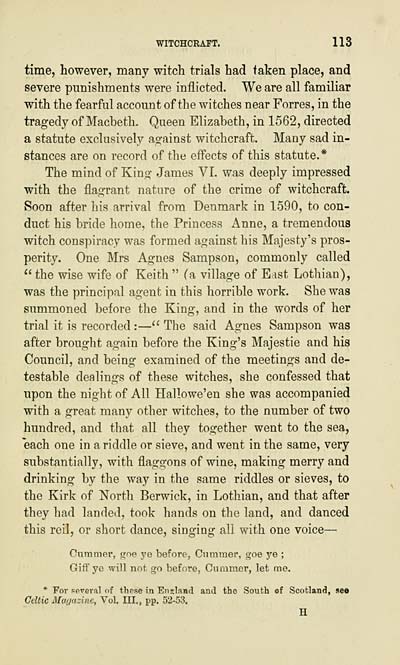Download files
Complete book:
Individual page:
Thumbnail gallery: Grid view | List view

WITCHCRAFT. 113
time, however, many witch trials had taken place, and
severe punishments were inflicted. We are all familiar
with the fearful account of the witches near Forres, in the
tragedy of Macbeth. Queen Elizabeth, in 1562, directed
a statute exclusively against witchcraft. Many sad in-
stances are on record of the effects of this statute.*
The mind of King James VI. was deeply impressed
with the flagrant nature of the crime of witchcraft.
Soon after his arrival from Denmark in 1590, to con-
duct his bride home, the Princess Anne, a tremendous
witch conspiracy was formed against his Majesty's pros-
perity. One Mrs Agnes Sampson, commonly called
" the wise wife of Keith " (a village of East Lothian),
was the principal agent in this horrible work. She was
summoned before the King, and in the words of her
trial it is recorded : — " The said Agnes Sampson was
after brought again before the King's Majestic and his
Council, and being examined of the meetings and de-
testable dealings of these witches, she confessed that
upon the night of All Hallowe'en she was accompanied
with a great many other witches, to the number of two
hundred, and that all they together went to the sea,
each one in a riddle or sieve, and went in the same, very
substantially, with flaggons of wine, making merry and
drinking by the way in the same riddles or sieves, to
the Kirk of North Berwick, in Lothian, and that after
they had landed, took hands on the land, and danced
this reil, or short dance, singing all with one voice —
Cummer, goe ye before, Cummer, goe ye ;
Giff ye will not go before, Cummer, let me.
* For several of these in England and the South of Scotland, see
Celtic Magazine, Vol. III., pp. 52-53.
H
time, however, many witch trials had taken place, and
severe punishments were inflicted. We are all familiar
with the fearful account of the witches near Forres, in the
tragedy of Macbeth. Queen Elizabeth, in 1562, directed
a statute exclusively against witchcraft. Many sad in-
stances are on record of the effects of this statute.*
The mind of King James VI. was deeply impressed
with the flagrant nature of the crime of witchcraft.
Soon after his arrival from Denmark in 1590, to con-
duct his bride home, the Princess Anne, a tremendous
witch conspiracy was formed against his Majesty's pros-
perity. One Mrs Agnes Sampson, commonly called
" the wise wife of Keith " (a village of East Lothian),
was the principal agent in this horrible work. She was
summoned before the King, and in the words of her
trial it is recorded : — " The said Agnes Sampson was
after brought again before the King's Majestic and his
Council, and being examined of the meetings and de-
testable dealings of these witches, she confessed that
upon the night of All Hallowe'en she was accompanied
with a great many other witches, to the number of two
hundred, and that all they together went to the sea,
each one in a riddle or sieve, and went in the same, very
substantially, with flaggons of wine, making merry and
drinking by the way in the same riddles or sieves, to
the Kirk of North Berwick, in Lothian, and that after
they had landed, took hands on the land, and danced
this reil, or short dance, singing all with one voice —
Cummer, goe ye before, Cummer, goe ye ;
Giff ye will not go before, Cummer, let me.
* For several of these in England and the South of Scotland, see
Celtic Magazine, Vol. III., pp. 52-53.
H
Set display mode to: Large image | Transcription
Images and transcriptions on this page, including medium image downloads, may be used under the Creative Commons Attribution 4.0 International Licence unless otherwise stated. ![]()
| Early Gaelic Book Collections > J. F. Campbell Collection > Prophecies of the Brahan seer (Coinneach Odhar Fiosaiche) > (125) |
|---|
| Permanent URL | https://digital.nls.uk/81547158 |
|---|
| Description | Volumes from a collection of 610 books rich in Highland folklore, Ossianic literature and other Celtic subjects. Many of the books annotated by John Francis Campbell of Islay, who assembled the collection. |
|---|
| Description | Selected items from five 'Special and Named Printed Collections'. Includes books in Gaelic and other Celtic languages, works about the Gaels, their languages, literature, culture and history. |
|---|

